Iron Age - Southern Europe - Sold antiquities
Archive of sold antiquities
All artefacts sold in our gallery are fully documented in our online archive and database. Being a specialist ancient art dealer, preserving also the more recent history of each and every piece sold in our shop is at our heart. That is particularly useful for artefacts that changed owners in the meantime. Information that may have been lost in the process can be easily restored from our archives. Please do not hesitate to contact us if you need further information about ancient items that have been sold in our gallery. We can help you with reconstructing the history of ownership for those items. All information about our customers will be kept confidential, of course.-
 Published etruscan hydria or amphora
Published etruscan hydria or amphora1969 on exhibition in the Stadtsparkasse Gelsenkirchen, published in the exhibition catalogue. Perfectly preserved, from an old German private collection, acquired in the 1970s at Galerie Hermanns, Munich. Coming with an ArtLoss certificate
Price: on request Large early Etruscan decorated jar
Large early Etruscan decorated jarNicely preserved, from an old German collection, acquired in the late1950s. Found in Latium region (Italy) near Sezze.
Price: on request Perfectly preserved Etruscan storage jar
Perfectly preserved Etruscan storage jarRare object type, perfectly preserved. From an old German collection, acquired in the late1950s. Found in Latium region (Italy) near Sezze.
Price: on request Large Etruscan oinochoe: Found in Cerveteri
Large Etruscan oinochoe: Found in CerveteriVery impressive, large vase from an old German collection, acquired in the late1950s. Found in a tomb near Cerveteri. Coming with an Art Loss certificate.
Price: on request Lekythos from Toledo Museum collection
Lekythos from Toledo Museum collectionEx collection Prof. G. Olcott, the first Columbia University professor for Roman archeology. Acquired from his estate 1912 by the Toledo Museum (Ohio), in the museum collection until 2017. Found in Apulia.
Price: on request Early large Etruscan bucchero oinochoe
Early large Etruscan bucchero oinochoeLarge jar with ovoid body and trefoil mouth. Decorated with carved lines. From an old German collection, acquired in the 1950s. Coming with an Art Loss certificate.
Price: on request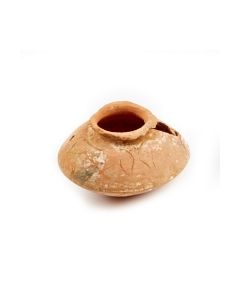 Italo-corinthian Pyxis with horses
Italo-corinthian Pyxis with horsesFrom an old Swiss collection, btw 1986 and 2001 on loan at the archeologic collection of the University of Zürich. About 6th century BC.
Price: on request Small bowl from Magna Graecia
Small bowl from Magna GraeciaFrom an old Swiss collection, btw 1986 and 2001 on loan at the archeologic collection of the University of Zürich. About 6th century BC.
Price: on request Etruscan bucchero oinochoe from an old collection
Etruscan bucchero oinochoe from an old collectionLarge jar with ovoid body and trefoil mouth. Decorated with carved lines. From the old German collection Dr. Tillmann. Coming with an Art Loss certificate.
Price: on request Large Etruscan bucchero oinochoe from Orvieto
Large Etruscan bucchero oinochoe from OrvietoPerfectly preserved, impressive jar. Never damaged or restored. Worth the exhibition in a museum. From the old German collection Dr. Tillmann. Coming with an Art Loss certificate.
Price: on request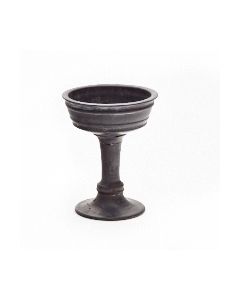 Tall Etruscan Chalice
Tall Etruscan ChaliceProbably manufactured at Vulci. From an old German collection Dr. Tillmann.
Price: on request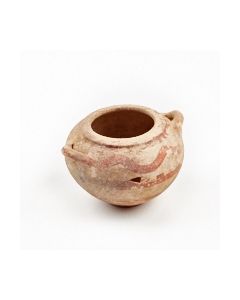 Italo-geometric jar with two handles
Italo-geometric jar with two handlesFrom an old Swiss collection, btw 1986 and 2001 on loan at the archeologic collection of the University of Zürich. 7th century BC, perfectly preserved ornamental painting.
Price: on request Cypriot bowl from the famous Severis collection
Cypriot bowl from the famous Severis collectionPerfectly preserved piece with very vivid bichrome decoration. Ex Christie's.
Price: on request Cypriot amphora from the famous Severis collection
Cypriot amphora from the famous Severis collectionEx Fortnum and Mason, London, UK. Impressive piece.
Price: on request Rare precursor of a bell krater
Rare precursor of a bell kraterFirst half 7th century BC, possibly slightly later. Decorated with geometric motifs. Very interesting, unpublished shape.
Price: on request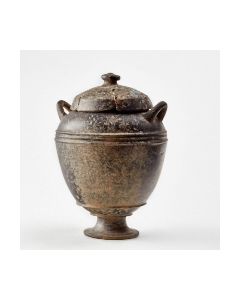 Etruscan bucchero urn with lid - found in Cerveteri
Etruscan bucchero urn with lid - found in CerveteriEarly 6th century BC. Perfectly preserved, from an old Swiss collection before 1930.
Price: on request 2 Skythische bis römische 3-flüglige Pfeilspitzen aus Bronze
2 Skythische bis römische 3-flüglige Pfeilspitzen aus BronzeDreiflüglig, Bronze, ohne Schaft. Typisch für Skythen ab ca. 700 v.Chr. Vermutlich jünger und von Söldnern im römischen Reich. 41mm, 17mm.
Price: on request 2 Skythische 3-flüglige Pfeilspitzen aus Bronze (AB)
2 Skythische 3-flüglige Pfeilspitzen aus Bronze (AB)Dreiflüglig, Bronze, ohne Schaft. Typisch für Skythen ab ca. 700 v.Chr. Vermutlich jünger und von Söldnern im römischen Reich. Ca. 15mm bis 25mm.
Price: on request Gruppe: 3 Skythische Pfeilspitzen (A-C)
Gruppe: 3 Skythische Pfeilspitzen (A-C)Dreiflüglig, Bronze, ohne Schaft. Typisch für Skythen ab ca. 700 v.Chr. Vermutlich jünger und von Söldnern im römischen Reich. Ca. 15mm bis 25mm.
Price: on request Gruppe: 5 Skythische Pfeilspitzen (F-J)
Gruppe: 5 Skythische Pfeilspitzen (F-J)Dreiflüglig, Bronze, ohne Schaft. Typisch für Skythen ab ca. 700 v.Chr. Vermutlich jünger und von Söldnern im römischen Reich. Ca. 15mm bis 25mm.
Price: on request Gruppe: 5 Skythische Pfeilspitzen (A-E)
Gruppe: 5 Skythische Pfeilspitzen (A-E)Dreiflüglig, Bronze, ohne Schaft. Typisch für Skythen ab ca. 700 v.Chr. Vermutlich jünger und von Söldnern im römischen Reich. Ca. 15mm bis 25mm.
Price: on request 2 Skythische bis römische 3-flüglige Pfeilspitzen aus Bronze
2 Skythische bis römische 3-flüglige Pfeilspitzen aus BronzeDreiflüglig, Bronze, ohne Schaft. Typisch für Skythen ab ca. 700 v.Chr. Vermutlich jünger und von Söldnern im römischen Reich. 23mm, 19mm.
Price: on request 2 Skythische bis römische 3-flüglige Pfeilspitzen aus Bronze
2 Skythische bis römische 3-flüglige Pfeilspitzen aus BronzeDreiflüglig, Bronze, ohne Schaft. Typisch für Skythen ab ca. 700 v.Chr. Vermutlich jünger und von Söldnern im römischen Reich. 25mm, 39mm.
Price: on request 2 Skythische bis römische 3-flüglige Pfeilspitzen aus Bronze
2 Skythische bis römische 3-flüglige Pfeilspitzen aus BronzeDreiflüglig, Bronze, ohne Schaft. Typisch für Skythen ab ca. 700 v.Chr. Vermutlich jünger und von Söldnern im römischen Reich. 21mm, 37mm.
Price: on request 5 Skythische 3-flüglige Pfeilspitzen aus Bronze
5 Skythische 3-flüglige Pfeilspitzen aus BronzeDreiflüglig, Bronze, ohne Schaft. Typisch für Skythen ab ca. 700 v.Chr. Vermutlich jünger und von Söldnern im römischen Reich. 25mm, 23mm, 22mm, 17mm, 25mm.
Price: on request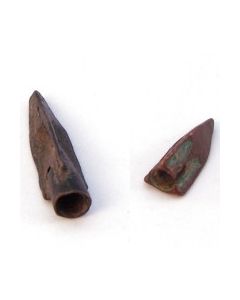 2 Skythische 3-flüglige Pfeilspitzen aus Bronze
2 Skythische 3-flüglige Pfeilspitzen aus BronzeDreiflüglig, Bronze, ohne Schaft. Typisch für Skythen ab ca. 700 v.Chr. Vermutlich jünger und von Söldnern im römischen Reich. 25mm und 16mm lang.
Price: on request 3 Skythische 3-flüglige Pfeilspitzen aus Bronze
3 Skythische 3-flüglige Pfeilspitzen aus BronzeDreiflüglig, Bronze, ohne Schaft. Typisch für Skythen ab ca. 700 v.Chr. Vermutlich jünger und von Söldnern im römischen Reich. 27mm, 18mm und 19mm lang.
Price: on request Keltisches Primitivgeld, Propellerform
Keltisches Primitivgeld, PropellerformAus Bronze, Schwarzmeerregion. Vormünzliche Geldform der Eisenzeit.
Price: on request Skythische 3-flüglige Pfeilspitzen aus Bronze
Skythische 3-flüglige Pfeilspitzen aus BronzeDreiflüglig, Bronze, sehr gute Erhaltung. Typisch für Skythen ab ca. 700 v.Chr. Aus dem danubischen Raum.
Price: on request Skythische 3-flüglige Pfeilspitzen aus Bronze
Skythische 3-flüglige Pfeilspitzen aus BronzeDreiflüglig, Bronze, sehr gute Erhaltung. Typisch für Skythen ab ca. 700 v.Chr. Aus dem danubischen Raum.
Price: on request Skythische 3-flüglige Pfeilspitzen aus Bronze
Skythische 3-flüglige Pfeilspitzen aus BronzeDreiflüglig, Bronze, sehr gute Erhaltung. Typisch für Skythen ab ca. 700 v.Chr. Aus dem danubischen Raum.
Price: on request Vormünzliche keltische Geldform
Vormünzliche keltische GeldformKeltisches Ringgeld, bestehend aus drei zusammengefügten Einzelringen. Eisenzeit. Aus dem danubischen Raum. 38mm Durchmesser.
Price: on request Hochgradig seltenes skythisches Protogeld in Pfeilform
Hochgradig seltenes skythisches Protogeld in Pfeilform7. - 6. Jh. v. Chr., Schwarzmeerregion, sehr guter Zustand
Price: on request

 Römisch-Skythische Pfeilspize
Römisch-Skythische PfeilspizeDreiflüglige Pfeilspitze in perfekter Erhaltung. Fundort: Niedergermanien.
Price: on request

